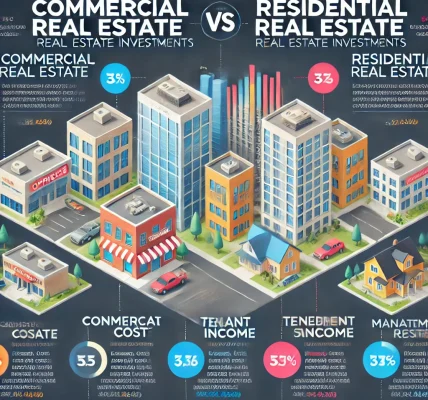Introduction
Investing in rental properties is a time-tested strategy for building wealth, generating passive income, and achieving financial stability. However, one of the most important decisions investors face is choosing between single-family homes (SFHs) and multi-family properties (MFHs). Each type of investment comes with unique benefits, risks, and financial implications.
This comprehensive guide explores the key differences between single-family and multi-family rental properties, helping you determine which investment aligns best with your goals, budget, and risk tolerance.
1. What is a Single-Family Rental Property?
A single-family home is a standalone residential property designed for one household. These properties typically include a yard, garage, and private space, making them popular among tenants seeking privacy and a suburban lifestyle.
Pros of Single-Family Rental Properties
✅ Lower Initial Investment – Generally, single-family homes have a lower purchase price than multi-family properties, making them more accessible to first-time investors.
✅ Easier Financing Options – Banks and mortgage lenders often offer favorable loan terms for single-family homes compared to multi-family units.
✅ Higher Tenant Demand – Many families, young professionals, and retirees prefer single-family homes due to privacy, outdoor space, and a residential feel.
✅ Stronger Appreciation Potential – Single-family homes tend to appreciate faster in value, especially in desirable neighborhoods.
✅ Lower Tenant Turnover – Tenants in single-family homes often sign longer leases, reducing vacancy rates and turnover costs.
Cons of Single-Family Rental Properties
❌ Limited Cash Flow – A single unit means rental income comes from only one tenant, which can be risky if the property is vacant.
❌ Higher Per-Unit Maintenance Costs – Maintenance and repair costs per unit tend to be higher because there’s only one rental income stream.
❌ Slower Portfolio Growth – Buying multiple single-family homes takes longer compared to acquiring a single multi-family property.
2. What is a Multi-Family Rental Property?
A multi-family property is a residential building that contains two or more rental units under one ownership. Examples include duplexes, triplexes, fourplexes, and apartment buildings.
Pros of Multi-Family Rental Properties
✅ Higher Cash Flow Potential – With multiple rental units generating income, investors benefit from higher total cash flow.
✅ Lower Risk of Complete Vacancy – Even if one unit is vacant, rental income from the other units helps cover expenses.
✅ More Efficient Property Management – Managing multiple units in one location is easier than maintaining multiple single-family homes in different areas.
✅ Scalability and Portfolio Growth – Investing in multi-family properties allows investors to scale their portfolios quickly by acquiring multiple rental units at once.
✅ Better Financing for Large Deals – Banks may offer commercial real estate loans with flexible terms for multi-family investments.
Cons of Multi-Family Rental Properties
❌ Higher Upfront Cost – Multi-family properties require a larger initial investment, which can be a barrier for new investors.
❌ Complex Management Requirements – Handling multiple tenants, maintenance requests, and potential conflicts requires professional property management or a significant time commitment.
❌ Stricter Loan Requirements – Financing multi-family properties, especially those with five or more units, may involve higher down payments and stricter lending criteria.
❌ Higher Tenant Turnover – Multi-family units may attract short-term tenants, increasing the likelihood of frequent turnovers and vacancies.
3. Key Factors to Consider When Choosing Between SFH and MFH
a) Investment Budget
- If you have a limited budget and prefer a lower-risk entry point, a single-family rental might be a better choice.
- If you have access to higher capital and want to generate higher cash flow, multi-family properties offer better scalability.
b) Rental Income and Cash Flow
- Single-family homes generally offer modest, stable rental income.
- Multi-family properties generate higher monthly cash flow but may come with higher expenses.
c) Risk Tolerance
- Lower risk tolerance → Choose single-family homes, as they tend to have longer leases and stable tenants.
- Higher risk tolerance → Choose multi-family homes, as they provide diversified income streams.
d) Property Management
- Do you want to self-manage? → Single-family homes are easier to manage.
- Do you prefer professional management? → Multi-family properties often require property management services.
e) Market Demand & Location
- In suburban areas, single-family homes are often in high demand.
- In urban and high-density areas, multi-family properties can attract a steady stream of renters.
4. Investment Scenarios: Which One Should You Choose?
Scenario 1: First-Time Investor with Limited Capital
➡ Best Choice: Single-Family Home ✅ Lower initial cost ✅ Easier financing ✅ Less management responsibility
Scenario 2: Investor Seeking Maximum Cash Flow
➡ Best Choice: Multi-Family Property ✅ Higher rental income ✅ Lower vacancy risk due to multiple units ✅ Faster portfolio growth
Scenario 3: Long-Term Appreciation Focus
➡ Best Choice: Single-Family Home ✅ Greater property appreciation potential ✅ Strong demand from homebuyers ✅ Easier resale compared to multi-family buildings
Scenario 4: Investor Looking for Passive Income
➡ Best Choice: Multi-Family Property (with property management) ✅ Professional management can handle day-to-day operations ✅ Consistent income from multiple tenants ✅ Potential for value-add strategies (renovations, rent increases)
5. Final Verdict: Which Investment is Right for You?
The decision between single-family and multi-family rental properties depends on your investment goals, financial situation, and risk tolerance.
- If you prefer lower risk, easier management, and long-term appreciation, single-family homes are a great starting point.
- If you prioritize higher cash flow, scalability, and portfolio growth, multi-family properties offer greater financial rewards despite higher management complexity.




